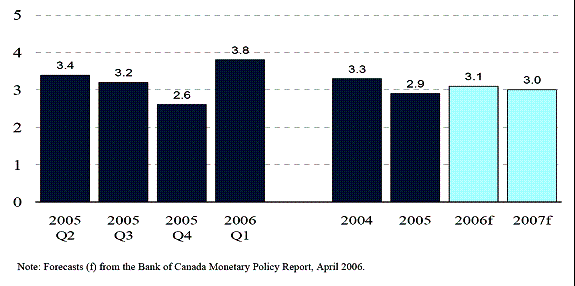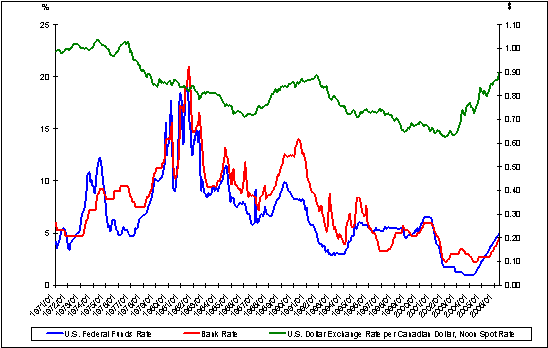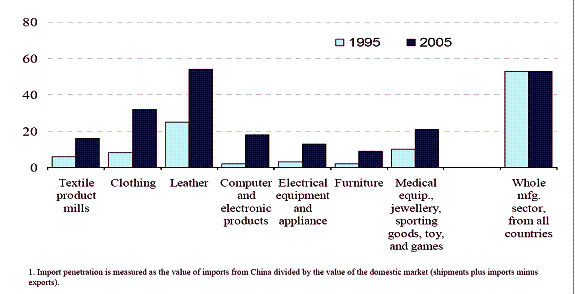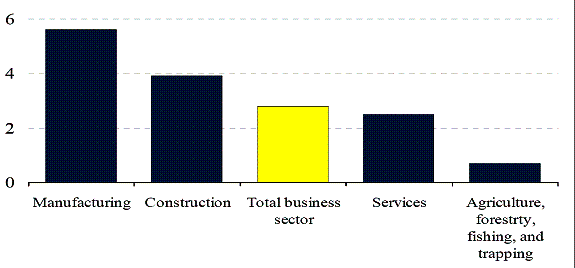INDU Committee Report
If you have any questions or comments regarding the accessibility of this publication, please contact us at accessible@parl.gc.ca.
CHALLENGES FACING THE CANADIAN
MANUFACTURING SECTOR
In May 2006, the House of Commons Standing Committee on Industry, Science and Technology began hearings on the current state of the Canadian manufacturing sector and the challenges facing this extremely important component of Canada’s economy. The study is focusing on four major issues and the impact that they are having on the competitiveness of the manufacturing sector: (1) the high value of the Canadian dollar; (2) high energy costs; (3) globalization; and (4) the availability of skilled labour. Additional issues raised by witnesses (e.g., the effect of the regulatory environment) are also being examined.
This interim report provides the Government of Canada with an overview of how the manufacturing sector is affected by the challenges noted above, and highlights other, often industry-specific, challenges that the sector is facing. Appendix A provides a summary of the principal recommendations made by the witnesses that have appeared before the Committee to date, and flags policy areas that the Committee will examine in more depth in the fall when it will continue its hearings.
OVERVIEW OF THE CANADIAN ECONOMY
Strong global demand for primary commodities (particularly base metals and energy) has led to high commodity prices, which, along with strong growth in final domestic demand, have fuelled robust economic growth in Canada over the last few years (Figure 1). The Bank of Canada judges that the Canadian economy has been operating at close to its full production capacity since the second quarter of 2004.1
This economic growth has led to an increase in the employment rate,2 which is at an all-time high (63.2% in May 2006). The unemployment rate stood at 6.1% in May 2006, its lowest level since December 1974. In Canada’s diversified economy, however, employment gains have not been experienced across all sectors of the economy. In the manufacturing sector employment has fallen by 8.0% (-187,000 jobs) since the end of 2002.3
Figure 1
Canada’s Real GDP Growth (% Annual Rate)4

In response to high commodity prices and currency traders’ concerns over the large U.S. current account deficit, the Canadian dollar has surged in value by almost 40%5 relative to the U.S. dollar since the beginning of 2003 (Figure 2) and receipts and payments between Canada and the rest of the world are in better balance.
All these economic indicators suggest the potential for an overheated economy (i.e., aggregate demand increasing beyond the economy’s production capacity) that could set off inflationary expectations if corrective monetary actions are not taken. The Bank of Canada has thus raised its overnight rate seven consecutive times by 25 basis points from 2.75% in September 2005 to 4.25% in May 2006 in order to keep inflation at the 2% midpoint of its target range of 1% to 3%. Increases in the overnight rate and other interest rates do exert upward pressure on the value of the Canadian dollar against other currencies, but Canada’s policy rate and other interest rates have been lower than their U.S. counterparts since early 2005 (Figure 2). Negative Canada-U.S. interest rate differentials dampen or slow the rise of the Canadian dollar, although this effect has been more than offset in recent months by rising commodity prices. The Bank of Canada suggests that commodity prices could increase further, which would imply stronger export demand and higher prices for Canada’s commodity exports, stronger income growth, and further upward pressure on the Canadian dollar.6
Figure 2
U.S. Federal Funds Rate, Canada Bank Rate and Canada-U.S. Dollar Exchange Rate 1971-20067

THE CANADIAN MANUFACTURING SECTOR AND ITS CHALLENGES
Manufacturing is Canada’s largest business sector, accounting for 18% of all of Canada’s economic activity and providing employment for 2.1 million people. Additionally, every dollar of manufacturing output is estimated to generate over three dollars of total economic activity.8 Manufacturing industry shipments were approximately $615 billion in 2005,9 of which $450 billion were exports. In 2005, the manufacturing sector accounted for two-thirds of Canada’s exports and two-thirds of Canada’s private sector R&D.
Despite Canada’s overall rosy economic picture, industries within the manufacturing sector are struggling with a number of major challenges that are affecting their competitiveness and, in some cases, their very survival. The principal challenges facing the sector are: (1) the rapid appreciation in the value of the Canadian dollar; (2) increasing energy costs; (3) competition from “Emerging Economies”; (4) the availability of skilled labour; and (5) the regulatory environment. Additional industry-specific challenges are discussed later in the report.
1. Rapid Appreciation in the Value of the Canadian Dollar
Relative to the services sectors, the manufacturing sector has a higher exposure to international trade. Exports from the manufacturing sector are often priced in U.S. dollars, and as the Canadian dollar has risen, margins have shrunk as the prices of these exports dropped in Canadian dollar terms. Because of competitiveness concerns or the fact that prices for exports may be fixed far in advance in U.S. dollars, many firms have been unable to raise their U.S. dollar prices.10
The manufacturing sector has also been adversely affected by increasing input costs. Energy-intensive manufacturing industries such as pulp and paper, chemical, petroleum refining and primary metal industries make up approximately 29% of Canada’s manufacturing GDP,11 and these industries have been hit particularly hard by increasing energy (electricity, fuel oil and natural gas) costs. Between the 1st quarter of 2000 and the 4th quarter of 2005, manufacturers saw their energy costs increase by 94.3% (Figure 3).
Figure 3
Percent Change in Input Costs, (1st Qtr 2000 – 4th Qtr 2005)12

3. Competition from Emerging Economies
The Canadian manufacturing sector has been affected by global competition, particularly from China. China is a large and rapidly growing market for raw materials, industrial goods, capital equipment, and consumer products. The country has become a leading manufacturer, not only of textiles and consumer products, but of electronic equipment, software, and other technologies as well. China’s labour costs are, on average, about 1/40th of those in Canada, and they provide China with a comparative advantage in the manufacture of labour-intensive products. China has also become an integral part of manufacturers’ global supply chains.13 Canada is also facing low cost and high value competition from other emerging economies, such as India.
Although import penetration into Canada from all countries has been relatively stable over the last decade, there has been a change in the relative positions of the countries of origin of imports. In particular, import penetration from China has risen. Some manufacturing industries with a high trade exposure have experienced lower profit margins, prices or sales volumes in their domestic markets because of increased competition from imports, particularly from China (Figure 4).
Figure 4
China’s Import Penetration: Most Exposed Manufacturing Industries14

4. Availability of Skilled Labour
Despite current job shedding, the manufacturing sector, like all other sectors of the Canadian economy, has to address the shortage (actual or potential, depending upon the industry in question) of skilled labour. Over the past decade, three main factors have shaped Canada’s workforce: (1) an increasing demand for skills in the face of advanced technologies and the “knowledge based economy”; (2) a working-age population that is increasingly made up of older people; and (3) a growing reliance on immigration as a source of skilled labour.15 According to a survey conducted by the Canadian Manufacturers and Exporters in 2003,16 more than 40% of manufacturers say that skills shortages are seriously constraining their ability to improve business performance and grow. About 17% of those surveyed indicated that skills shortages pose a major constraint on their ability to develop and commercialize new products. Finally, slightly more than 25% reported that a lack of skilled and experienced personnel is a challenge that will fundamentally change the nature of their business over the next 5 to 10 years.
Although not cited as the main challenge to competitiveness by any of the groups representing specific manufacturing industries, some of the witnesses indicated that government regulations represent a burden to their industry and to all sectors of the economy. The major business associations (e.g., Canadian Manufacturers and Exporters, Canadian Chamber of Commerce, Canadian Council of Chief Executives, Canadian Federation of Independent Businesses, Conference Board of Canada) suggested that streamlining regulations and reducing paper burden is a cost-effective way to increase productivity and to help businesses of all sizes and from all sectors.
THE MANUFACTURING SECTOR’S RESPONSES TO CHALLENGES
The rapid appreciation in the value of the Canadian dollar, along with higher energy costs and strong competition from emerging economies such as China and India, have had a negative impact on profitability in many parts of the manufacturing sector. In response to these challenges, many firms in the manufacturing sector have had to take a variety of measures to adjust to the changes. The responses include lowering labour costs, increasing inputs/processing abroad, increasing investment in machinery and equipment, raising selling prices, reorienting production and increasing financial hedging.17
As many manufacturing firms have restructured their operations, employment in the sector has declined. Statistics Canada reports that employment in the manufacturing sector declined by 22,000 in May 2006, with losses spread between Ontario and Quebec. Since the end of 2002 when the downward trend for the sector’s employment levels began, manufacturing employment has fallen by 8.0% (-187,000 jobs).18 In 2005, the manufacturing sector was the economy’s major source of job losses. The decline in manufacturing employment over the last three years is the largest period of contraction in the sector since the recession of the early 1990s. It should be noted, however, that in the three years ending in 1992, manufacturing jobs declined at twice the rate that they have over the last three years.19
Recent job losses have occurred across all parts of the manufacturing sector, but have been particularly marked in clothing and textiles, computer and electronic manufacturing, electrical equipment and appliances, transportation equipment, and wood and paper products. Similarly, manufacturing job losses have been experienced in most provinces, but Ontario and Quebec have been hit particularly hard. The decline in the share of total employment by the manufacturing sector is not unique to Canada; other OECD countries have also witnessed similar declines.
To further improve productivity and decrease costs, Canadian manufacturers have increased capital spending substantially. While job losses in the sector have been substantial, output levels have not declined by as much because of these investments, and thus manufacturing labour productivity increased at an average annual rate of 5.6% per quarter over the past six quarters, which is twice the average for the business sector as a whole (Figure 5).
Figure 5
Average Growth in Labour Productivity by Industrial Sector:
2004 Q3 to 2006 Q1 (% Annual Rate)20

CHALLENGES FACING SELECTED INDUSTRIES WITHIN THE MANUFACTURING SECTOR
Mass production of apparel in Canada began in the mid-19th century in many urban centres, which supplied much-needed semi-skilled labour but were also the major consumer markets. For most of that time, domestic production closely matched domestic demand in terms of quantities, qualities and style requirements. The second half of the 20th century (by contrast) was marked by a substantial increase in world trade in apparel, mostly originating from low wage, developing countries and destined for high wage, developed countries. Two attempts to address the imbalances and inequities caused by this growing trade were made and they resulted in two multilateral international agreements: the Multi-Fibre Arrangement (MFA), which permitted developed countries to impose quotas on imports of apparel and textiles from developing countries, and the Agreement on Textiles and Clothing (ATC), whereby the MFA quotas were to be gradually phased out over a 10-year period. These two agreements marked 1975, 1995 and 2005 as milestones for three distinct and increasingly freer trade regimes. The Canada-U.S. Free Trade Agreement (FTA) also played a role — a positive one — as exports to the United States soared and now account for 40% of Canadian apparel shipments valued at $5.6 billion in 2005.
In and of itself, the ATC posed significant competitiveness challenges to the Canadian apparel industry, particularly from the export of cheap Chinese, Indian and Bangladeshi clothing. Canadian apparel companies were adjusting to the new trade environment by shifting and focusing their production on selected North American niche markets, whereby geographical proximity to these markets would provide a competitive advantage, such as in the case of their “fast fashion” segments. However, the 40% appreciation of the Canadian dollar against the U.S. dollar in only the past three years has hobbled the implementation of such strategies given that U.S. apparel companies are reacting similarly. Much greater contraction and consolidation of the Canadian apparel industry, along with more lay-offs, are expected should current trends continue. To mitigate such a scenario, the industry believes that government action is needed on tariff policy and procurement, as well as continuing general support for the industry.
The textiles industry is one of Canada’s oldest manufacturing industries. Established more than 150 years ago in small, urban communities that offered a stable labour supply and rivers ideally suited for water-generated power and dyeing/finishing, the industry started with the manufacture of yarns and fabrics from natural fibres. Today, the industry is structured very differently. Canada’s textiles manufacturing industry has transformed itself, particularly in the past 25 to 30 years, through substantial and sustained capital investment and the result is a modern industry that is increasingly capital-intensive, a major user of high technology, and a provider of quality jobs for thousands of Canadians. In 2005, the industry is located mostly in Quebec and Ontario and uses natural, artificial and man-made fibres and filaments to produce and ship $6.2 billion worth of textiles and textile products, of which $3.0 billion or about 48% was exported.
The Canadian market for textiles appears to have peaked at a level just shy of $11 billion in 2000, declining more than 20% in the past five years. This slump in demand is more protracted than a simple downturn in the economy — trade factors are at play. Indeed, the ATC and the rapid appreciation of the Canadian dollar have together sharpened the industry’s competitiveness challenge. The industry is prepared to meet this challenge but is seeking from the federal government complementary industrial and trade policies in the areas of an export processing strategy and on the rules of origin governing duty-free entry of imported apparel from least developed countries (LDCs).
Canada’s forest industry sold some 250 products, valued at $81 billion in 2004, to more than 175 countries, generating $35 billion in trade surplus. Canada ranked first in the world in terms of newsprint production and second in the world in terms of both wood pulp production and softwood lumber production.
As the forestry sector is simultaneously highly energy-intensive, capital-intensive and export-oriented, the rapidly rising prices of energy and the Canadian dollar present the sector with its greatest competitiveness challenges. Somewhat linked to these challenges is the sector’s fragmented industrial structure. Canada’s two largest forestry companies, Abitibi-Consolidated and Domtar Canada, rank just 21st and 23rd among the largest forest companies of the world. Significant economies of scale exploited through further industry consolidation could bode capital cost savings and would help towards levelling the competitiveness playing field with its much larger foreign rivals. The industry believes that the Government of Canada can play a significant role in improving the investment climate for the industry, most notably by taking various measures that would lower the marginal effective tax rate on capital. The industry also believes that a more accommodating application of the Competition Act would be part of its competitiveness solution and that a Canada-Korea free trade agreement would provide incremental benefits.
Rapid growth in the Canadian plastics industry followed the dramatic increase in the domestic capacity for producing synthetic resins beginning in the late 1970s which was, in turn, a response to the OPEC oil embargo and energy crisis. During that period, U.S. tariffs on imported resins were typically 10 to 12%, whereas they were 3 to 5% for plastic products. This tariff differential spawned vertically integrated production of resin and plastics in western Canada. Today, Canada boasts more than 2,000 plastics companies, mostly Canadian-owned small and medium-size enterprises (SMEs), whose shipments were more than $20 billion in 2005, of which 50% was exported (and of which 93% was destined for the United States).
The industry faces a number of competitiveness challenges that include: (1) the small size of many of its Canadian companies; (2) the need to match high R&D rates of their U.S. competitors; and (3) a more secure supply of its Canadian natural gas feedstock. As resin costs typically account for 30 to 50% of the final value of a plastics product and one dollar of natural gas at the wellhead can be turned into a $15 plastic product — hence, a value-added multiplier of 15 — the development of a federal energy framework that would ensure adequate feedstock for manufacturing (rather than exporting so much natural gas in its raw state) and the stabilization of energy prices is seen by the industry as a way to boost its competitiveness. The industry has also indicated that acceleration of the capital cost allowance to no greater than two years, and a simplification of Canada’s R&D tax credit regime are top priorities to assist it in meeting its innovation challenge.
Canada has attracted a number of foreign automobile manufacturers (i.e., DaimlerChrysler, Ford, General Motors, Honda, Suzuki, and Toyota) to locate their production facilities mostly in southern Ontario, producing for the North American market, while at the same time importing a substantial amount of vehicles to match its varied automotive needs. Based on relatively lower wage rates than those of the United States, and federal and Ontario government financial support of $434 million and $513.8 million, respectively, in the last two years alone, capital expenditures in Canada’s automotive assembly plants have been brisk, averaging more than $3 billion per year over the past 12 years. As a result of these investments, Canada’s automotive assembly plants are estimated to be, on average, 4.6% more productive than those of the United States and 38.9% more productive than those of Mexico. In turn, Canadian production accounted for about 17% of North American production and Canada-U.S. automotive trade amounted to $143.8 billion, with a Canadian surplus of $23.5 billion, in 2005.
With many countries also subsidizing investment in their automotive sectors, leading to a world and North American automotive assembly plant overcapacities estimated at 11.5 and 2.5 million units, respectively, and a 40% appreciation of the Canadian dollar against the U.S. dollar in just the past three years, Canada’s labour cost advantage is rapidly shrinking. The appreciation of the Canadian dollar has been particularly hard on the automotive assembly supply-chain, and the availability of both general skilled and technical skilled workers is also a growing concern. These factors are threatening industry profitability, labour wage increases and Canada’s trade surplus. The industry suggests that it may be threatened further by a Canada-Korea free trade agreement if market access and measures such as Korea’s non-tariff barriers are not addressed. The industry also believes that a lower marginal effective tax rate on capital, one that is competitive with that of the United States, would provide a favourable investment climate.
The Canadian aerospace industry boasts more than 500 companies with annual revenues of $21.7 billion in 2004, placing Canada in 4th position behind aerospace industries in the United States, United Kingdom and France. This Canadian industry is extraordinarily dependent on foreign buyers of its products, as 84% of its revenues were garnered from export sales and 75% of all exports were to the United States.
The global aerospace industry does not operate in a laissez-faire marketplace. Government intervention in the sector is rationalized primarily on national security grounds and secondarily on grounds of industry characteristics such as its high degree of R&D and its attendant high risks and long payback periods. Governments around the world use various policy instruments to support aerospace industries operating within their jurisdictions, including funding defence programs and purchases, financing research and development infrastructure, and providing loan guarantees and bank financing for aircraft development and production. In Canada, major federal programs and initiatives used by the aerospace industry include: (1) Scientific Research and Experimental Development (SR&ED) Tax Incentive Program; (2) Technology Partnerships Canada; (3) Defence Research and Development Canada; and (4) the National Research Council’s Institute for Aerospace Research, Aerospace Manufacturing Technology Centre and Industrial Research Assistance Program (IRAP).
Given that the aerospace industry’s long-term survival and prosperity depend on innovation and one of the basic building blocks of that activity is R&D, which in the last decade represented between 6 and 15% of industry sales, the industry believes that it is crucial that the Government of Canada redevelop and replace the Technology Partnerships Canada program as a means of levelling the playing field with its foreign rivals. Any improvements to the SR&ED tax measure as an incentive to encourage R&D, particularly for SMEs, would also be welcomed by the industry.
| 1 | Bank of Canada, Monetary Policy Report, April 2006, http://www.bankofcanada.ca/en/mpr/pdf/mprapr06.pdf. |
| 2 | The employment rate is the percentage of working-age people who have jobs. The employment rate denominator is the source population, not the labour force. The source population includes all working-age people not in the military or institutions, but the labour force includes only those persons who either have a job or are looking for one. |
| 3 | Statistics Canada, Labour Force Survey, May 2006, http://www.statcan.ca/english/Subjects/Labour/LFS/lfs.pdf. |
| 4 | Industry Canada submission to the House of Commons Standing Committee on Industry, Science and Technology, meeting of 13 June 2006. |
| 5 | Comparison between the base case (denominator) of 64.9¢ on 1 January 2003 and value of 90.1¢ on 1 May 2006. |
| 6 | Bank of Canada, Monetary Policy Report, April 2006, p. 28. |
| 7 | Bank of Canada, Rates and Statistics, http://www.bankofcanada.ca/en/graphs/currencies.html#us. |
| 8 | Data from Canadian Manufacturers and Exporters. |
| 9 | Data from April 2005-May 2006. Statistics Canada, Monthly Survey of Manufacturing, April 2006, June 2006, http://www.statcan.ca/Daily/English/060614/d060614a.htm. |
| 10 | Bank of Canada, “Adjusting to the Appreciation of the Canadian Dollar”, Supplement to the Spring 2006 Business Outlook Survey, http://www.bankofcanada.ca/en/bos/2006/spring/adj_e_0406.pdf. |
| 11 | Data presented by Mr. Howard E. Brown, Assistant Deputy Minister, Department of Natural Resources to the House of Commons Standing Committee on Industry, Science and Technology, meeting of 13 June 2006. |
| 12 | Canadian Manufacturers and Exporters submission to the House of Commons Standing Committee on Industry, Science and Technology, meeting of 16 May 2006. |
| 13 | Canadian Manufacturers and Exporters, Manufacturing Challenges in Canada http://www.cme-mec.ca/mfg2020/Challengespdf.pdf. |
| 14 | Industry Canada submission to the House of Commons Standing Committee on Industry, Science and Technology, meeting of 13 June 2006. |
| 15 | Statistics Canada, 2001 Census analysis series: The changing profile of Canada’s labour force, 2003, www12.statcan.ca/english/census01/Products/Analytic/companion/paid/pdf/96F0030XIE2001009.pdf. |
| 16 | Canadian Manufacturers and Exporters 2003 Membership Survey cited in Canadian Manufacturers and Exporters, Manufacturing Challenges in Canada, http://www.cme-mec.ca/mfg2020/Challengespdf.pdf. |
| 17 | Bank of Canada, “Adjusting to the Appreciation of the Canadian Dollar,” Supplement to the Spring 2006 Business Outlook Survey, http://www.bankofcanada.ca/en/bos/2006/spring/adj_e_0406.pdf. |
| 18 | Statistics Canada, Labour Force Survey, May 2006, http://www.statcan.ca/english/Subjects/Labour/LFS/lfs.pdf. |
| 19 | Vincent Ferrao, "Recent Changes in Employment by Industry, "Perspectives on Labour and Income, Statistics Canada, January 2006, p. 7 http://www.statcan.ca/english/freepub/75-001-XIE/10106/art-1.pdf. |
| 20 | Industry Canada submission to the House of Commons Standing Committee on Industry, Science and Technology, meeting of 13 June 2006. |